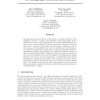640 search results - page 121 / 128 » Architectural paradigms for robotics applications |
NIPS
2007
13 years 9 months ago
2007
Biological movement is built up of sub-blocks or motion primitives. Such primitives provide a compact representation of movement which is also desirable in robotic control applica...
CASES
2007
ACM
2007
ACM
INTACTE: an interconnect area, delay, and energy estimation tool for microarchitectural explorations
13 years 11 months ago
Prior work on modeling interconnects has focused on optimizing the wire and repeater design for trading off energy and delay, and is largely based on low level circuit parameters....
IROS
2007
IEEE
14 years 1 months ago
2007
IEEE
— Any system that has the capability to diagnose and recover from faults is considered to be a fault-tolerant system. Additionally, the quality of the incorporated fault-toleranc...
IJCNN
2000
IEEE
13 years 11 months ago
2000
IEEE
The field of human-computer interaction has been widely investigated in the last years, resulting in a variety of systems used in different application fields like virtual reality...
ATAL
2008
Springer
13 years 9 months ago
2008
Springer
Bots for Real Time Strategy (RTS) games provide a rich challenge to implement. A bot controls a number of units that may have to navigate in a partially unknown environment, while...

